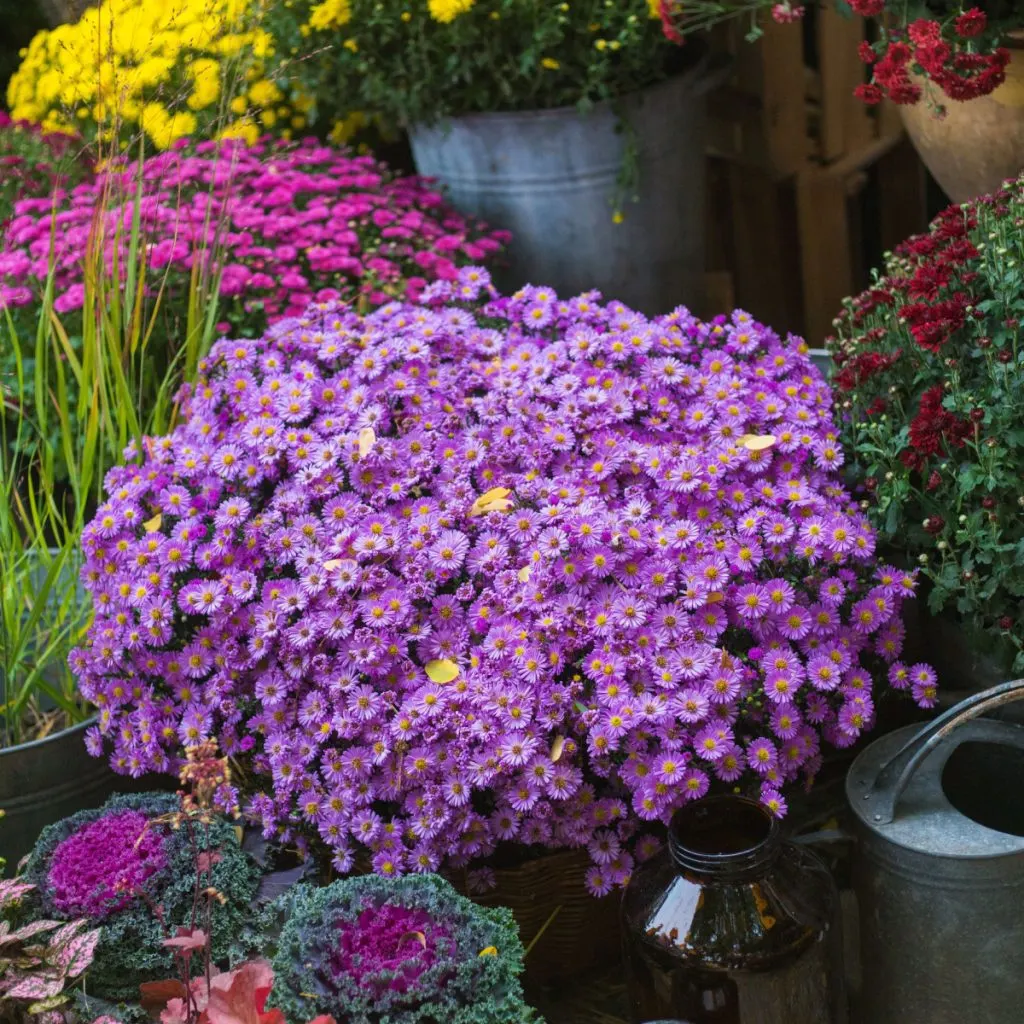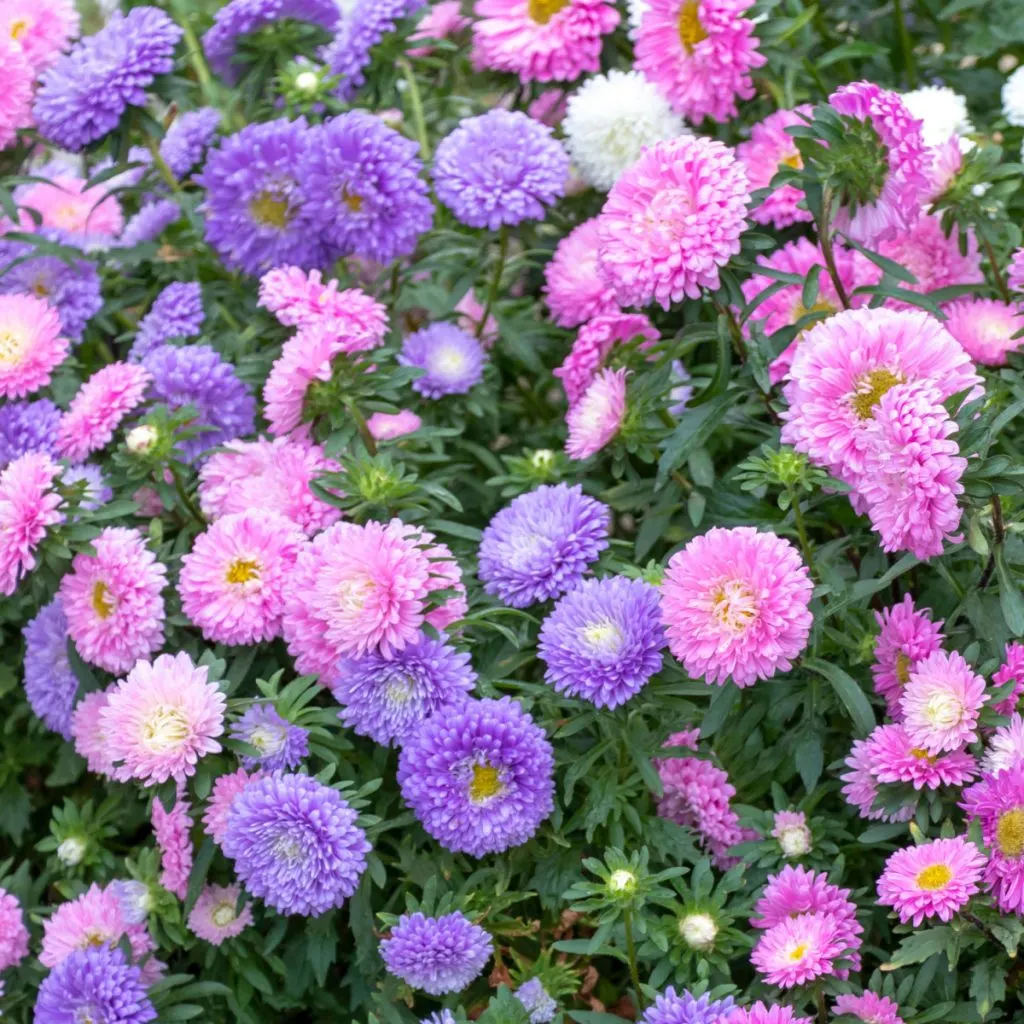Wondering if you can keep the potted asters you purchased this fall alive through the winter to grow again next year? Well the good news is you can – and it’s easier than you ever imagined!
Asters are right up there with mums when it comes to fall decorating. In fact, with their wide range of blooming colors and their ability to cover their entire canopy of foliage in a mass of flowers, they might be the best choice of all. Which is exactly why you see more and more stores selling potted asters along with mums with each passing year.
But these perennial plants are so much more than just a fall decoration. And although they can’t make it through the winter outside in their pots, with just a little preparation, they are easy to save. Not only to grow in pots again next year – but to thrive in flowerbeds and gardens as well!

How To Keep Potted Asters Alive Over The Winter
Step 1 – Bringing Your Asters In Before A Frost Or Freeze
One of the biggest mistakes gardeners make when trying to save fall blooming plants such as asters or mums is allowing them to stay outdoors too long. Bringing them indoors before the first frost or freeze is crucial to their survival. See: How To Save Potted Mums – 4 Simple Steps To Store Mums Indoors For The Winter!
Exposure to freezing temperatures can cause the foliage to wilt and die. That, in turn, forces the plant to spend precious energy repairing damage rather than preparing for winter dormancy. But even more, cold can also cause serious issues for the plant’s root system.
When grown in pots, asters are more vulnerable to temperature changes. Containers don’t benefit from the thermal insulation of surrounding soil or the protection of mulch. The sun can warm the soil in a pot quickly on mild days, but when temperatures suddenly drop, the soil can freeze just as fast.
Once the roots are injured, it can be difficult for the plant to recover. Which is exactly why if a frost or cool temperatures are in the forecast, it’s important to cover or bring your asters in for protection. And once those cold temperatures start to stick around, it’s time to prepare your potted asters for life indoors over winter.

Overwintering Asters Indoors – How To Keep Potted Asters Alive Over The Winter
Unfortunately, because potted asters are used for decorating so late in the season, planting them in flowerbeds after the fall season is over does not allow them the necessary time to establish their roots before winter arrives. And that means the plants will likely freeze out.
Asters can actually survive indoors with ease – simply by allowing them to go dormant. When bringing asters indoors, start by trimming the plant back to three or four inches above the soil line. This will help to prevent leaf drop indoors and make the plant far more manageable.
Always remove any decorative wrapping from the pot to allow the plant to breathe and maintain proper oxygen flow. Then, lightly moisten the soil before moving it inside and place the pot in a cool spot with low to moderate light.
The space should be protected from drafts and not reach freezing temperatures. Unheated basements or garages work very well for this. The goal is to allow the plant to go dormant in cool temperatures without freezing out.

Water the soil occasionally to keep it slightly damp. For most, this will mean a light watering every two to three weeks. It’s more important to avoid overwatering as it can lead to root rot.
An Outside Alternative – How To Keep Potted Asters Alive Over The Winter
If indoor space is limited, you can attempt to leave your potted asters outside with some extra protection. The best method for this is to place the pot into a hole in the ground to insulate it from rapid temperature fluctuations.
Cover the area with four to six inches of mulch for added insulation. Don’t trim the foliage when overwintering outside as it will provide more protection against the cold. Again, it’s far better if you do have the room to overwinter them indoors versus outdoors.
Replanting Asters In The Spring – How To Keep Potted Asters Alive Over The Winter
When temperatures consistently reach the low 50s (F) during the day, it’s safe to bring asters back outside. Gradually reintroduce them to the outdoors to slowly bring them out of dormancy.

How you care for them beyond this point will all center around if you want to plant them into your flowerbeds – or keep them in pots.
For flowerbeds, you can plant asters in the ground once the threat of frost has passed. Simply dig a planting hole twice as wide and a few inches deeper than your pot. Amend the planting hole with compost and plant so that the crown of the plant is level with the surrounding soil.
If you prefer to keep them in containers, you will need to repot your aster plants with new soil. Asters require a fair amount of nutrients to bloom, and last year’s growth will have taken most of the energy in the soil up. Without giving your plants fresh soil, they will struggle to survive let alone bloom.
If the roots of your aster plant have outgrown its pot, early spring is the perfect time to divide them before repotting. To divide, simply cut the plant in half or in four equal sections to create new plants.
Pinching Back Asters In Mid Summer – How To Keep Potted Asters Alive Over The Winter
Just as with mums, you will want to pinch back or cut back asters in mid summer to allow them to have a full flush of fall blooms. This is true for asters in pots or if they are growing in flowerbeds.
Cutting it back in mid July keeps the plant thicker and less straggly in appearance. It also helps the blooms form more tightly. Continue to water your plant through and new bloom buds should begin to appear in late summer.
If you replanted in pots, you will need to bring them back indoors before a freeze in late fall. If you have replanted into flowerbeds, since they had the summer to establish, they will be more than fine.
Here is to saving your potted aster plants this fall, and to enjoying them again next year for free!
Simple Garden Life
Follow Our Facebook Page For Even More Great Tips! Simple Garden Life Facebook Page
Simple Garden Life is a website dedicated to keeping gardening fun, simple and enjoyable! We publish two new articles each week along with a new garden podcast episode every two weeks. This article may contain affiliate links.
